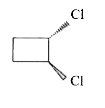Which of the following are undifferentiated, actively dividing cells?
parenchyma
collenchyma
sclerenchyma
meristematic
The correct Answer is:D
To solve the question "Which of the following are undifferentiated, actively dividing cells?" we need to analyze the options provided: parenchyma, collenchyma, sclerenchyma, and meristematic tissue.
1. Understanding the Types of Tissues:
- Parenchyma: This is a type of ground tissue composed of living cells that are usually thin-walled and unspecialized. They can differentiate into various types of cells and are involved in functions like photosynthesis and storage. However, they are not primarily known for being actively dividing or undifferentiated.
2. Analyzing Collenchyma:
- Collenchyma: This tissue provides support to the plant and consists of living cells with irregularly thickened walls. While it is living and provides structural support, it is also differentiated and not primarily involved in active division.
3. Examining Sclerenchyma:
- Sclerenchyma: This is a type of ground tissue that consists of dead cells with thick walls. It provides rigidity and support to the plant. Since these cells are dead and have thickened walls, they are not actively dividing or undifferentiated.
4. Identifying Meristematic Tissue:
- Meristematic Tissue: This is the key tissue type that consists of undifferentiated, actively dividing cells. These cells are the building blocks for all other types of plant tissues and are characterized by their ability to divide and differentiate into various specialized cells. They have a large nucleus and no intercellular spaces.
5. Conclusion:
- Based on the analysis, the correct answer to the question is meristematic tissue, as it is the only option that consists of undifferentiated, actively dividing cells.
Final Answer:
The correct option is meristematic tissue.
---
- Parenchyma: This is a type of ground tissue composed of living cells that are usually thin-walled and unspecialized. They can differentiate into various types of cells and are involved in functions like photosynthesis and storage. However, they are not primarily known for being actively dividing or undifferentiated.
2. Analyzing Collenchyma:
- Collenchyma: This tissue provides support to the plant and consists of living cells with irregularly thickened walls. While it is living and provides structural support, it is also differentiated and not primarily involved in active division.
- Sclerenchyma: This is a type of ground tissue that consists of dead cells with thick walls. It provides rigidity and support to the plant. Since these cells are dead and have thickened walls, they are not actively dividing or undifferentiated.
- Meristematic Tissue: This is the key tissue type that consists of undifferentiated, actively dividing cells. These cells are the building blocks for all other types of plant tissues and are characterized by their ability to divide and differentiate into various specialized cells. They have a large nucleus and no intercellular spaces.
- Based on the analysis, the correct answer to the question is meristematic tissue, as it is the only option that consists of undifferentiated, actively dividing cells.
The correct option is meristematic tissue.
Topper's Solved these Questions
- ANATOMY OF FLOWERING PLANTS - PLANT TISSUESBOOK - ICSECHAPTER - ANATOMY OF FLOWERING PLANTS - PLANT TISSUESEXERCISE - REVIEW QUESTIONS (ONE WORD QUESTIONS)
10 Videos
- ANATOMY OF FLOWERING PLANTS - PLANT TISSUESBOOK - ICSECHAPTER - ANATOMY OF FLOWERING PLANTS - PLANT TISSUESEXERCISE - REVIEW QUESTIONS (MATCHING)
1 Videos
- ANATOMY OF FLOWERING PLANTS BOOK - ICSECHAPTER - ANATOMY OF FLOWERING PLANTS EXERCISE - Ncert Exercises (Differentiate Between )
23 Videos
- ANIMAL KINGDOMBOOK - ICSECHAPTER - ANIMAL KINGDOMEXERCISE - Ncert Exercises (Differentiate between )
11 Videos
Similar Questions
Knowledge Check
Which of the following are optically active?
A B
B CCH3−CH∣D−COOHD
CCH3−CH∣D−COOHD
Which of the following are optically active?
A B
B C
C D
D
Which of the following compounds is optically active?
A B
B C
C D
D
Which of the following alkanes is optically active ?
View SolutionWhich of the following is/are optically active?
View SolutionWhich of the following biphenyl is optical active:
View SolutionWhich of the following compounds is optically active?
View SolutionWhich of the following compounds is optically active ?
View Solution

